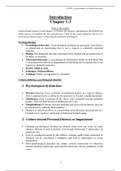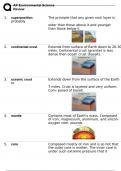Summary
Summary Psychology 314 Exam (Chapter 5-13)
- Course
- Institution
- Book
This summery includes the Chapter 1-3 introduction and PowerPoint slides and pictures. I assure quality notes that will guarantee much more than a pass. I read the entire textbook and included everything you need to know for the predicate test and the exams. Chapter 9 not covered.
[Show more]













